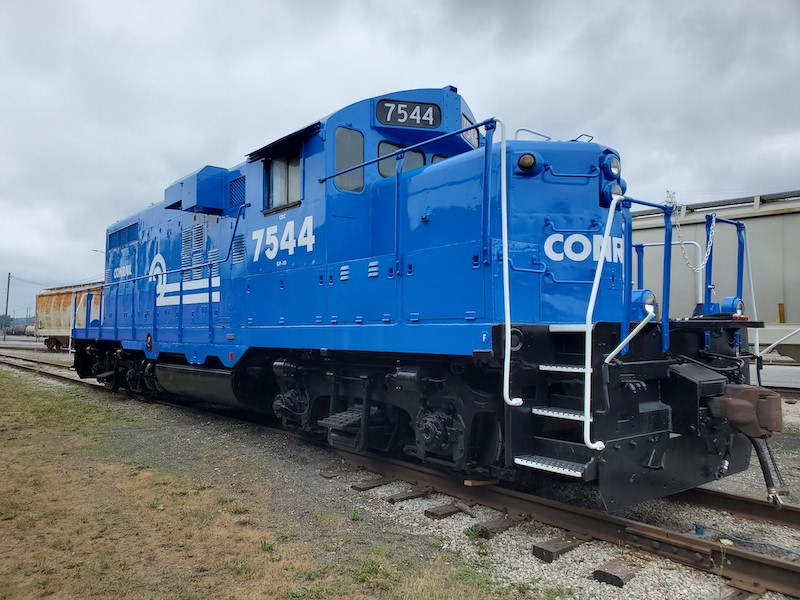By Eric Berger
LEBANON, Ohio — The once familiar sight of an operating Conrail GP10 is returning to Ohio, thanks to Ray Kammer Jr. and his Cincinnati Scenic Railway, with a retroactive assist from the old Illinois Central.
Soon after its creation, Conrail began sending GP7 and GP9 locomotives inherited from Penn Central to Illinois Central for rebuilding at its Paducah shops, which had created the GP8 and GP10 models to extend the lives of its own aging Geeps. Ultimately, 76 GP10s were built in the 7500-number series by 1979, with some coming from Precision National and Morrison-Knudson. From then until the mid-1990s, it seemed you couldn’t go anywhere in Ohio without seeing one or more of the units in yard or local service.
A few years after the GP10s were retired, the railroad itself would disappear, along with the blue and white Conrail paint which dominated the northeastern portion of the nation for nearly a quarter century. The former mainlines and branches of the mighty Pennsy, New York Central and Erie Lackawanna across Ohio would be divided between CSX and Norfolk Southern, eventually downgraded, splintered and sometimes abandoned. All of which helped make it possible for Kammer to create the Cincinnati Scenic Railway and subsidiaries Lebanon, Mason & Monroe Railroad and Ohio Railway Experience.
The leased rails on which Kammer’s trains operate were mainly PRR and NYC tracks originally, so when he bought a GP10 from the Tennessee Central Railway, the choice of Conrail paint followed quickly, since neither PRR, NYC nor PC operated a GP10, with its tell-tale air filter appendage. It was assigned road number 7544, one of the numbers in the 7500 series never actually used on a Conrail unit, because it was originally an Illinois Central engine. The only exterior difference is a headlight on its chopped short hood not found on the Conrail units.
Originally a GP9 built as IC 9037 in 1954, it was outshopped as a GP10 in 1974 and renumbered ICG 8008. It had a second career as Paducah & Louisville 8349 before going to the museum. Though it apparently had not run for about 18 years, an inspection last year revealed the prime mover wasn’t frozen and its general condition was good. Silcott Railway Equipment of Worthington, Ohio, was contracted to handle moving the engine to the Midwest Railway Preservation Society facility in the B&O roundhouse in Cleveland, where it berthed next to another engine undergoing restoration, Reading 4-8-4 2100.
Silcott also handled the electrical and mechanical work on the engine, which quickly became a bigger job than expected. Preliminary work included replacing stolen batteries and a missing fuel pump and governor, changing filters, and replacing injectors.
But when Silcott mechanic Mike Schreiber fired her up for the first time, acrid smoke began emanating from the main generator. It was shot, partly a victim of poorly applied and broken insulation tape, but also because the armature itself was grounded from sitting so many years after being baked by multiple attempts to operate it. The problem was resolved with the installation of a replacement found in Texas.
When a traction motor problem was discovered, Schreiber pulled both trucks and replaced and resoldered both parts of all 16 of the “handshake” electrical connections to the motors, as well as their brushes, and repacked the brake cylinders. Nearly six months of mechanical work concluded last fall with three flawless hours of operation.
Next came several months of work on the car body restoration and painstaking recreation of the Conrail paint scheme by the Midwest Railway Preservation Society. The rights to all Conrail intellectual property still belong to Consolidated Rail Corporation, which survives as a switching and terminal railroad owned in equal part by CSX and NS. An officer of the company gave approval to the use of the paint scheme, with the proviso that it be stated somewhere on the exterior that the locomotive is not owned or operated by Consolidated Rail. That led to a unique idea from CSR Chief Mechanical Officer Scott Jarrett: put that language on a metal plate in the same style as the equipment trust plates that used to be attached to locomotive engine frames, usually next to the builder’s plate, displaying the name of the financial institution that owned the locos until they were paid off.
The engine is expected to arrive at the company headquarters in Lebanon in August, where it will join other members of the CSR/LMM fleet, two GP30s, former Nickel Plate Road 901 and 902, and C&O 5407, a 1950 unit believed to be the oldest continuously operating GP7.



